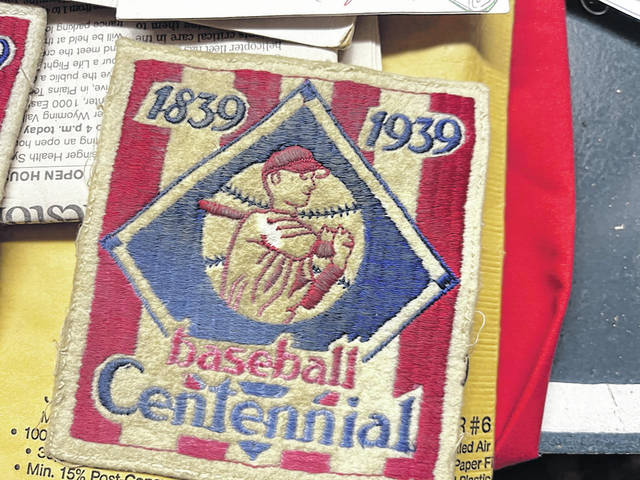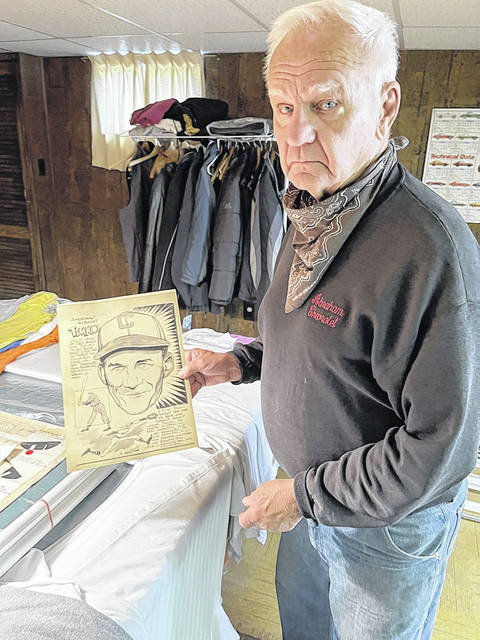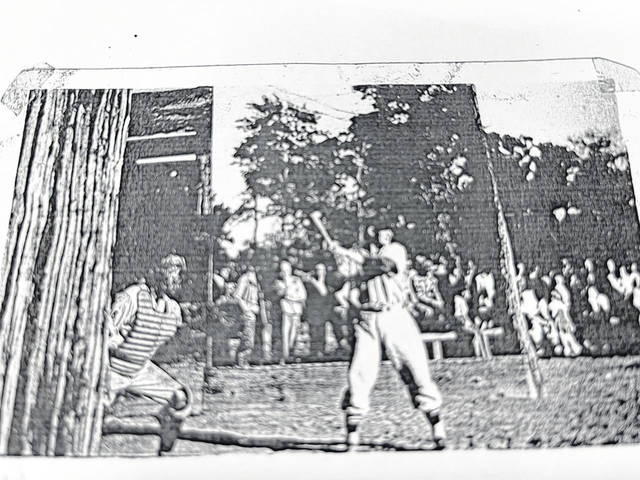
An official team portrait of the Sans Souci Smilers of 1944. Andrew Timko is in the top row, third from right. Next to Timko is John Gunshor, first baseman, who was a milkman for Grablick’s Dairy.
Photo courtesy of Jack Timko
Decades ago, Sunday was for baseball and local teams drew thousands
After church services were over, many families would head to Sans Souci Park, not to ride the roller coaster, but to watch a ball game.
On those beautiful, sunny Sundays in the 1940s, still dressed in their Sunday best, they would enter the car, park their car and walk under The Bear Cat roller coaster, down a path to the ball park.
That’s where the Sans Souci Smilers of the Lower Valley Baseball League played their home games before a well-dressed, beer drinking crowd in the hundreds.
“Those were the days,” said Jack Timko of Plains Township, whose dad, Andrew, played for the Smilers and other teams, including the St. Louis Cardinals of the National League. “I was just a little kid, but I remember the crowds and the baseball was great.”
Timko’s father told him a lot of stories of those good old days when the Smilers won most of their games and the beer was flowing and the players were best described as “blood and guts” men who loved the game. The batters didn’t wear helmets, body armor, batting gloves or shin guards.
“Fans were eyewitnesses to the game of baseball and the way it should be played,” former coach and official John Kashatus wrote of the long ago era. “While it is inevitable that these men came from ‘The Greatest Generation,’ it is easy to understand why these ‘hometown heroes’ were adored by their fans and respected by so many people throughout the Wyoming Valley and NEPA.”
Timko, now 80, is a former police chief of Plains Township. In his basement is a collection of baseball memorabilia, artifacts, photographs, newspaper clippings and, most of all, cherished memories.
When you walk around the room, Timko shows you one item after another and he will offer a story about each. Timko, himself a great player in the 1950s and 1960s, has manged to compile his own baseball Hall of Fame in his basement,
And the stories, oh the stories.
Like when his dad would show up for a Smilers’ game. He would first stop at the manager’s house to put on his uniform.
“And there would be a twenty dollar bill in the pants pocket,” Timko said.
And then off to the game.
You see, Timko’s father was really good.
“He told me that he could see the ball hit the bat,” Timko said. “Can you believe that? I had trouble seeing the ball at all.”
Timko’s dad was a coal miner in the off-season. He batted .299 in 1944 with Rochester Red Wings and the next year, the Cardinals offered him $350. He didn’t accept it and returned to Plains.
The Legendary
Glen Lyon Condors
John Kashatus, a former baseball coach and PIAA official, wrote a detailed account of baseball back in the day, featuring many teams, but focusing on the Glen Lyon Condors. His feature story ran in the fall 2019 edition of the Newport Township Community News.
“That was the big leagues around here,” Kashatus said.
He talked about the Wyoming League and the Luzerne County League, which like the Lower Valley League, featured some of the best players ever to play in the area.
The teams had names like the Sans Souci Smilers and Glen Lyon Condors, and Mayflower Barons, Plymouth’s Orchard Street Nine, Buttonwood Cubs, Honey Pot Miners, Nanticoke Round Up, Mocanaqua A’s, and teams from Breslau, Hanover and Brookside, which played at Hollenback Park.
Kashatus wrote about his uncle, Joe Bouika, a Huntington Mills graduate who was a catcher.
“The pre-war Condors recalled the outstanding pitching of Roxy Bush and Doc, the spectacular defense of George Dunn and Levi, the superb catching of Roman Piestrak, the all-around play of Jocko and Sweeney and the hitting of AK and Odinetz,” was how Kashatus described what his uncle told him. “The Condors played like a well-oiled machine and ‘outclassed’ their opponents.”
The Condors played at Weinick Park, which was built by the M.A. Hannah Coal Co. William E. Weinick was the name of the coal company’s superintendent. Kashatus wrote, “It was a pristine setting above 7 Shaft Hill, adjacent to the state highway leading into Glen Lyon from the west.”
Kashatus said his uncle and his father often talked about how polished the players were and the large crowds that attended the games — 1,000 to 2,000 fans were common for the games. In fact, Kashatus said in 1940, the Luzerne County League’s championship game attracted an estimated crowd of 4,300 fans.
Kashatus said there were so many good players around that Glen Lyon had two teams for a while — the Condors and the Kanadians — who held a joint banquet each year.
Kashatus said the Luzerne County League (1940) had eight teams in the Southern Division and eight teams in the Northern Division. Prior to that, the Condors played in the Wyoming League, and afterward in the N.E.P., N.E.L., and finally in the Wyoming League.
Kashatus wrote about the names of Condors’ players, like “AK, Doc, Levi, Jocko, Sweeney, Dunn, Kriefski, Dane, plus Marty Warmus, Zig Najaka, Kazmir Gregorowicz and Tom Sugalski.”
Kashatus said the Condors had a “reputation” as one tough baseball team.
“Not only were they talented, but they had developed a great chemistry and love for the game,” Kashatus wrote. Many of the Condors honed their skills by playing mid-week, which improved their Sunday performances.
As these men returned from a real life “arena of war,” Kashatus said they traded their “combat gear” for wool-flannel uniforms, cleated-leather shoes and mitts to prepare for action in their own “personal battlefield” on the hill at Weinick Park.
“They were aware of tradition as they took their hand mowers to practices on Saturdays to ‘tidy up’ the field after a practice session,” Kashatus wrote. “The Condors’ talent, determination and work ethic were on display to crowds of a few thousand fans during Sunday afternoons in the summer and early fall. The success of this baseball franchise, especially in the post-war years, created a ‘Legacy for the Ages.’
“The Condors were truly the heart and soul of this coal mining community of Glen Lyon.”
The Central League
The Lower Valley League, Wyoming League and Luzerne County League lasted through the 1950s, and then the Central League was formed and featured many great players from local towns.
Jack Timko pitched for the Ashley A’s and later for Hilldale.
Timko’s father, Andrew, played with Joe Garagiola, Walter Alston, Harvey Haddix and Preacher Row and many other Major League Baseball stars.
John Kashatus managed in the Glen Lyon team in the Central League.
Timko said the blood and guts style of players like his father and the players of the Lower Valley League was evident in the Central League.
Timko was no exception. He told of a story when he was a junior at Plains High School. He said the manager of Sacred Heart’s team of the Catholic League called him and told him to come to his house. Timko said when he arrived at the house, the manager told him to put on a Sacred Heart uniform.
“I told him I don’t go to Sacred Heart. I go to Plains,” Timko said. “He told me to put the uniform on because I was pitching that day against St. Vincent’s of Plymouth.”
Now the story goes, according to Timko, that St. Vincent’s was the best team around and they had an outstanding pitcher as well — Bobby Mullery.
Timko said he was pitching a no-hitter against the Vinnies when it was discovered Timko was not a student at Sacred Heart. He said the game was forfeited to St. Vincent’s, but the game continued and Timko completed the no-hitter.
“Sacred Heart hadn’t won a game all year,” Timko said. “So their manager just decided to get me to pitch the game for them. He didn’t think anyone would notice.”
And Timko and Mullery became close friends after that.
Timko pitched two no-hitters in a three-day span in 1959, stopping Old Boston 3-0 on a Sunday and then Fort-Swoyer 1-0 two days later while pitching for Hilldale.
He was 5-8, 145 pounds back then and a left-handed hurler. In his senior year at Plains High School, he no-hit Swoyersville twice. That season, in addition to the two no-hitters, Timko also had two one-hitters and he struck out 68 batters in 34 innings.
Timko signed with the Milwaukee Braves and became close friends with Ron Hunt, playing together in Cedar Rapids Iowa. Hunt visited Timko in Plains many times and the two would travel to New York for the Mets old timers games. Timko was Hunt’s best man in his wedding.
In 1964, Timko was MVP of the Central League, pitching for Ashley. He later was an assistant coach for Wilkes College and also worked with the Mets pitchers.
Married to the former Dorothy Bushkar of Wyoming. Timko has two brothers, Andy and Ron, who both were also outstanding athletes.
Timko loves to tell stories. He said Hunt played for the Milwaukee Braves, but ended up with the New York Mets because the Braves had guys like Roy McMillian and Eddie Matthews.
Timko sad Hunt caught the eye of Mets’ owner Joan Payson at a game in Texas. Payson liked the way Hunt hustled — he finished second to Pete Rose for National League Rookie of the Year in 1963.
Timko said Hunt was glad to join the Mets because it was like coming home for the New Jersey native. And Hunt had a good career with the Mets, Dodgers, Giants, Expos and Cardinals — in 1971, he even set a record for being hit by a pitch with 50.
Timko met Hunt in the minor leagues in Waycross Georgia of the Braves organization. In fact, Joe Torre was his roommate.
When Hunt was with the Mets, Timko said he would go to games and sit in the dugout next to Mets manager Casey Stengel, who, he said, often fell asleep during games.
After Stengel retired, the Mets hired Wes Westrum to manage and he and Hunt were at odds.
“Westrum wanted somebody else to play second,” Timko said. “Hunt said he told Westrum that he was the second baseman until Westrum found somebody better. The next thing Hunt knew, he was in Montreal.”
The Expos played at Jarry Park, a small facility with far less capacity than Shea Stadium.
“It was like playing at Hilldale,” Timko said.
Epilogue
Timko and Kashatus are representatives of an era when baseball was the true national pastime. They played when fans flocked to games, as did their fathers.
Kashatus had this to say about baseball:
“Baseball is a team game that provides opportunities for any one player to excel in the ‘moment.’ It has been said that baseball is a tranquil game until ‘unwrapped violence’ occurs. The player or players who excel during that drama become heroes.
“Baseball is more than a game, it is a “romance story” between the endeared and revered players and the fans who support them.”
Kashatus cited a quote by the late Yankee pitcher Jim Bouton, writer of “Ball Four,” as he explains the human connection to the game.
“You spend a good piece of your life gripping a baseball and in the end it turns out that it was the other way around all the time.”
Kashatus, Timko and all those players of the past know exactly what Bouton meant.
Reach Bill O’Boyle at 570-991-6118 or on Twitter @TLBillOBoyle.









